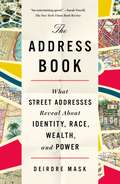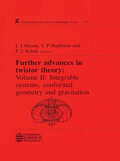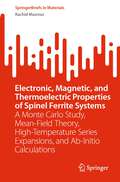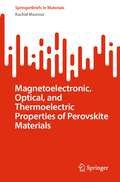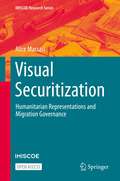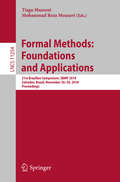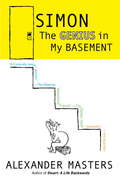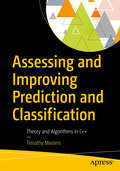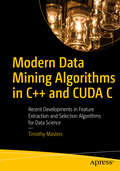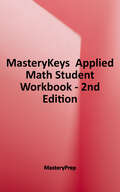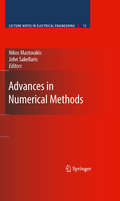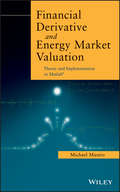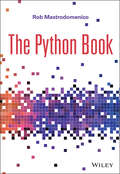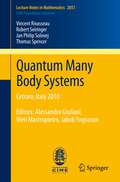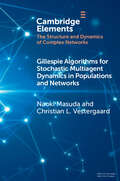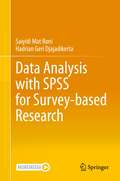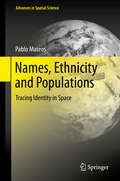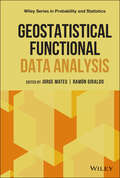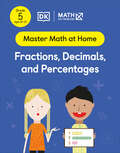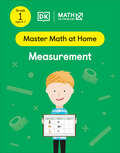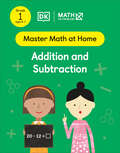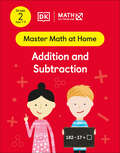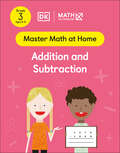- Table View
- List View
The Address Book: What Street Addresses Reveal About Identity, Race, Wealth, and Power
by Deirdre MaskAn extraordinary debut in the tradition of classic works from authors such as Mark Kurlansky, Mary Roach, and Rose George.An exuberant and insightful work of popular history of how streets got their names, houses their numbers, and what it reveals about class, race, power, and identity.When most people think about street addresses, if they think of them at all, it is in their capacity to ensure that the postman can deliver mail or a traveler won’t get lost. But street addresses were not invented to help you find your way; they were created to find you. In many parts of the world, your address can reveal your race and class. In this wide-ranging and remarkable book, Deirdre Mask looks at the fate of streets named after Martin Luther King Jr., the wayfinding means of ancient Romans, and how Nazis haunt the streets of modern Germany. The flipside of having an address is not having one, and we also see what that means for millions of people today, including those who live in the slums of Kolkata and on the streets of London. Filled with fascinating people and histories, The Address Book illuminates the complex and sometimes hidden stories behind street names and their power to name, to hide, to decide who counts, who doesn’t—and why.
Further Advances in Twistor Theory: Volume II: Integrable Systems, Conformal Geometry and Gravitation (Chapman And Hall/crc Research Notes In Mathematics Ser. #232)
by L.J. Mason L.P. Hughston P.Z. KobakTwistor theory is the remarkable mathematical framework that was discovered by Roger Penrose in the course of research into gravitation and quantum theory. It have since developed into a broad, many-faceted programme that attempts to resolve basic problems in physics by encoding the structure of physical fields and indeed space-time itself into the complex analytic geometry of twistor space. Twistor theory has important applications in diverse areas of mathematics and mathematical physics. These include powerful techniques for the solution of nonlinear equations, in particular the self-duality equations both for the Yang-Mills and the Einstein equations, new approaches to the representation theory of Lie groups, and the quasi-local definition of mass in general relativity, to name but a few. This volume and its companions comprise an abundance of new material, including an extensive collection of Twistor Newsletter articles written over a period of 15 years. These trace the development of the twistor programme and its applications over that period and offer an overview on the current status of various aspects of that programme. The articles have been written in an informal and easy-to-read style and have been arranged by the editors into chapter supplemented by detailed introductions, making each volume self-contained and accessible to graduate students and non-specialists from other fields. Volume II explores applications of flat twistor space to nonlinear problems. It contains articles on integrable or soluble nonlinear equations, conformal differential geometry, various aspects of general relativity, and the development of Penrose's quasi-local mass construction.
Electronic, Magnetic, and Thermoelectric Properties of Spinel Ferrite Systems: A Monte Carlo Study, Mean-Field Theory, High-Temperature Series Expansions, and Ab-Initio Calculations (SpringerBriefs in Materials)
by Rachid MasrourThis book explores magnetic properties and critical temperatures in inverse ferrite Fe₃⁺(M₂⁺Fe₃⁺)O₄ spinels (e.g., Fe, Co, Ni). It calculates transition and Curie Weiss temperatures, providing insights into their thermodynamic behavior. Using the full potential linearized augmented plane wave (FP-LAPW) method, it investigates electrical and magnetic structures of spinel chromite, revealing magnetic moments in MnCr₂S₄. Seebeck coefficient and electrical conductivity are also calculated. Advanced techniques like Monte Carlo, DFT+U, and FLAPW analyze magnetic characteristics of LiMn₁.₅Ni₀.₅O₄ and electronic/magnetic structures of Fe₃O₄. High-temperature series expansions calculate Néel temperature and critical exponents, while GFT determines thermal magnetization and susceptibility. The analysis exposes exchange interactions' effects on magnetic order and introduces asymmetric phases in ferrimagnetic spinel systems. This book serves as an invaluable resource for researchers, academics, and enthusiasts seeking a comprehensive understanding of magnetic properties and critical phenomena within diverse spinel materials.
Magnetoelectronic, Optical, and Thermoelectric Properties of Perovskite Materials (SpringerBriefs in Materials)
by Rachid MasrourThis book undertakes an extensive exploration of manganese-based compounds, such as T₁₋ₓSrxMnO₃ (T = La, Pr; x = 0.35, 0.25) using density functional theory and Monte Carlo simulations with a focus on understanding their electronic, magnetic, and magnetocaloric properties. Ba₁₋ₓSrxFeO₃ (x = 0, 0.2) is also studied via different approximations, offering a comparative perspective. In addition, the book looks at the influence of magnetism using Monte Carlo simulations, revealing crucial parameters and examining the GdCrO₃ system through DFT and Monte Carlo simulation, shedding light on recent experimental observations. Additionally, Monte Carlo studies investigate magnetic and magnetocaloric features of Sr₂FeMoO₆, La₂SrMn₂O₇ bilayer manganite, perovskite ferromagnetic thin films' surface effects, and SmFe₁₋ₓMnxO₃ perovskite. In essence, this book significantly advances our comprehension of magnetic and magnetocaloric phenomena across diverse materials and is well-suited for both experimentalists and computational researchers working in this field.
Visual Securitization: Humanitarian Representations and Migration Governance (IMISCOE Research Series)
by Alice MassariThis open access book offers an innovative account of how relief organizations’ visual depiction of Syrian displacement contributes to reproduce and reinforce a securitized account of refugees. Through visual analysis, the book demonstrates how the securitization process takes place in three different ways. First of all, even if marginally, it occurs through the reproduction of mainstream media and political accounts that have depicted refugees in terms of threats. Secondly, and more consistently, through a representation of Syrian displaced people that, despite the undeniable innovative aesthetic patterns focusing on dignity and empowerment, continue to reinforce a visual narrative around refugees in terms of victimhood and passivity. The reproduction of a securitized account takes also place through the dialectic between what is made visible in the pictures and what is not. At the same time the book identifies visual glimmers and minor displacements in the humanitarian discourse that have the potentiality to produce alternative discourses on refugees and displacement beyond the mainstream securitized ones. By showing how relief organizations’ visual representation contributes to the securitization of the refugee issue, this book provides a great resource to students and academics in migration, visuality, humanitarianism and securitization, as well as social scientists and policy-makers.
Auxiliary Polynomials in Number Theory
by David MasserThis unified account of various aspects of a powerful classical method, easy to understand in its simplest forms, is illustrated by applications in several areas of number theory. As well as including diophantine approximation and transcendence, which were mainly responsible for its invention, the author places the method in a broader context by exploring its application in other areas, such as exponential sums and counting problems in both finite fields and the field of rationals. Throughout the book, the method is explained in a 'molecular' fashion, where key ideas are introduced independently. Each application is the most elementary significant example of its kind and appears with detailed references to subsequent developments, making it accessible to advanced undergraduates as well as postgraduate students in number theory or related areas. It provides over 700 exercises both guiding and challenging, while the broad array of applications should interest professionals in fields from number theory to algebraic geometry.
Worldwide Differential Calculus
by David B. MasseyOur goal with this textbook is, of course, to help you learn Differential Calculus (the Calculus of derivatives). But why publish a new textbook for this purpose when so many already exist? There are several reasons why we believe that our textbook is a vast improvement over those already in existence.
Formal Methods: 21st Brazilian Symposium, SBMF 2018, Salvador, Brazil, November 26–30, 2018, Proceedings (Lecture Notes in Computer Science #11254)
by Tiago Massoni Mohammad Reza MousaviThis book constitutes the refereed proceedings of the 21st Brazilian Symposium on Formal Methods, SBMF 2018, which took place in Salvador, Brazil, in November 2018.The 16 regular papers presented in this book were carefully reviewed and selected from 30 submissions. The papers are organized in topical sections such as: techniques and methodologies; specification and modeling languages; theoretical foundations; verification and validation; experience reports regarding teaching formal methods; and applications.Chapter “TeSSLa: Temporal Stream-Based Specification Language” is available open access under a Creative Commons Attribution 4.0 International License via link.springer.com.
Simon
by Alexander MastersAlexander Masters tripped over his first book subject on a Cambridge sidewalk, and the result was the multi-award-winning bestseller Stuart: A Life Backwards. His second, he's found under his floorboards. One of the greatest mathematical prodigies of the twentieth century, Simon Norton stomps around Alexander's basement in semidarkness, dodging between stalagmites of bus timetables and engorged plastic bags, eating tinned kippers stirred into packets of Bombay mix. Simon is exploring a theoretical puzzle so complex and critical to our understanding of the universe that it is known as the Monster. It looks like a sudoku table--except a sudoku table has nine columns of numbers. The Monster has 808017424794512875886459904961710757005754368000000000 columns. But that's not the whole story. What's inside the decaying sports bag he never lets out of his clutches? Why does he hurtle out of the house in the middle of the night? And--good God!--what is that noxious smell that creeps up the stairwell? Grumpy, poignant, comical--more intimate than either the author or his quarry intended--Simon: The Genius in My Basement is the story of a friendship and a pursuit. Part biography, part memoir, and part popular science, it is a study of the frailty of brilliance, the measures of happiness, and Britain's most uncooperative egghead eccentric.From the Hardcover edition.
Assessing and Improving Prediction and Classification: Theory and Algorithms in C++
by Timothy MastersThis book begins by presenting methods for performing practical, real-life assessment of the performance of prediction and classification models. It then goes on to discuss techniques for improving the performance of such models by intelligent resampling of training/testing data, combining multiple models into sophisticated committees, and making use of exogenous information to dynamically choose modeling methodologies. Rigorous statistical techniques for computing confidence in predictions and decisions receive extensive treatment. Finally, a hundred pages are devoted to the use of information theory in evaluating and selecting useful predictors. Special attention is paid to Schreiber's Information Transfer, a recent generalization of Grainger Causality. Well commented C++ code is given for every algorithm and technique. The ultimate purpose of this text is three-fold. The first goal is to open the eyes of serious developers to some of the hidden pitfalls that lurk in the model development process. The second is to provide broad exposure for some of the most powerful model enhancement algorithms that have emerged from academia in the last two decades, while not bogging down readers in cryptic mathematical theory. Finally, this text should provide the reader with a toolbox of ready-to-use C++ code that can be easily incorporated into his or her existing programs.
Modern Data Mining Algorithms in C++ and CUDA C: Recent Developments in Feature Extraction and Selection Algorithms for Data Science
by Timothy MastersDiscover a variety of data-mining algorithms that are useful for selecting small sets of important features from among unwieldy masses of candidates, or extracting useful features from measured variables. As a serious data miner you will often be faced with thousands of candidate features for your prediction or classification application, with most of the features being of little or no value. You’ll know that many of these features may be useful only in combination with certain other features while being practically worthless alone or in combination with most others. Some features may have enormous predictive power, but only within a small, specialized area of the feature space. The problems that plague modern data miners are endless. This book helps you solve this problem by presenting modern feature selection techniques and the code to implement them. Some of these techniques are:Forward selection component analysis Local feature selection Linking features and a target with a hidden Markov model Improvements on traditional stepwise selection Nominal-to-ordinal conversion All algorithms are intuitively justified and supported by the relevant equations and explanatory material. The author also presents and explains complete, highly commented source code. The example code is in C++ and CUDA C but Python or other code can be substituted; the algorithm is important, not the code that's used to write it. What You Will Learn Combine principal component analysis with forward and backward stepwise selection to identify a compact subset of a large collection of variables that captures the maximum possible variation within the entire set. Identify features that may have predictive power over only a small subset of the feature domain. Such features can be profitably used by modern predictive models but may be missed by other feature selection methods. Find an underlying hidden Markov model that controls the distributions of feature variables and the target simultaneously. The memory inherent in this method is especially valuable in high-noise applications such as prediction of financial markets. Improve traditional stepwise selection in three ways: examine a collection of 'best-so-far' feature sets; test candidate features for inclusion with cross validation to automatically and effectively limit model complexity; and at each step estimate the probability that our results so far could be just the product of random good luck. We also estimate the probability that the improvement obtained by adding a new variable could have been just good luck. Take a potentially valuable nominal variable (a category or class membership) that is unsuitable for input to a prediction model, and assign to each category a sensible numeric value that can be used as a model input. Who This Book Is For Intermediate to advanced data science programmers and analysts. C++ and CUDA C experience is highly recommended. However, this book can be used as a framework using other languages such as Python.
MasteryKeys: Applied Math Student Workbook
by MasteryPrepFrom this book you will learn addition, subtraction, multiplication, and division. You will learn how to convert numbers between fractions, decimals, and percentages. Lastly, you will learn how to solve problems dealing with negative numbers, money, and time.
Advances in Numerical Methods (Lecture Notes in Electrical Engineering #11)
by Nikos Mastorakis John SakellarisRecent Advances in Numerical Methods features contributions from distinguished researchers, focused on significant aspects of current numerical methods and computational mathematics. The increasing necessity to present new computational methods that can solve complex scientific and engineering problems requires the preparation of this volume with actual new results and innovative methods that provide numerical solutions in effective computing times. Each chapter will present new and advanced methods and modern variations on known techniques that can solve difficult scientific problems efficiently.
Financial Derivative and Energy Market Valuation
by Michael MastroA road map for implementing quantitative financial modelsFinancial Derivative and Energy Market Valuation brings the application of financial models to a higher level by helping readers capture the true behavior of energy markets and related financial derivatives. The book provides readers with a range of statistical and quantitative techniques and demonstrates how to implement the presented concepts and methods in Matlab®.Featuring an unparalleled level of detail, this unique work provides the underlying theory and various advanced topics without requiring a prior high-level understanding of mathematics or finance. In addition to a self-contained treatment of applied topics such as modern Fourier-based analysis and affine transforms, Financial Derivative and Energy Market Valuation also:* Provides the derivation, numerical implementation, and documentation of the corresponding Matlab for each topic* Extends seminal works developed over the last four decades to derive and utilize present-day financial models* Shows how to use applied methods such as fast Fourier transforms to generate statistical distributions for option pricing* Includes all Matlab code for readers wishing to replicate the figures found throughout the bookThorough, practical, and easy to use, Financial Derivative and Energy Market Valuation is a first-rate guide for readers who want to learn how to use advanced numerical methods to implement and apply state-of-the-art financial models. The book is also ideal for graduate-level courses in quantitative finance, mathematical finance, and financial engineering.
The Python Book
by Rob MastrodomenicoThe Python Book Discover the power of one of the fastest growing programming languages in the world with this insightful new resource The Python Book delivers an essential introductory guide to learning Python for anyone who works with data but does not have experience in programming. The author, an experienced data scientist and Python programmer, shows readers how to use Python for data analysis, exploration, cleaning, and wrangling. Readers will learn what in the Python language is important for data analysis, and why. The Python Book offers readers a thorough and comprehensive introduction to Python that is both simple enough to be ideal for a novice programmer, yet robust to be useful for those more experienced in the language. The book assists budding programmers to gradually increase their skills as they move through the book, always with an understanding of what they are covering and why it is useful. Used by major companies like Google, Facebook, Instagram, Spotify, and more, Python promises to remain central to the programming landscape for years to come. Containing a thorough discussion of Python programming topics like variables, equalities and comparisons, tuple and dictionary data types, while and for loops, and if statements, readers will also learn: How to use highly useful Python programming libraries, including Pandas and Matplotlib How to write Python functions and classes How to write and use Python scripts To deal with different data types within Python Perfect for statisticians, computer scientists, software programmers, and practitioners working in private industry and medicine, The Python Book will also be of interest to students in any of the aforementioned fields. As it assumes no programming experience or knowledge, the book is ideal for those who work with data and want to learn to use Python to enhance their work. <P><P><i>Advisory: Bookshare has learned that this book offers only partial accessibility. We have kept it in the collection because it is useful for some of our members. Benetech is actively working on projects to improve accessibility issues such as these.</i>
Quantum Many Body Systems
by Vieri Mastropietro Jakob Yngvason Vincent Rivasseau Jan Philip Solovej Thomas Spencer Alessandro Giuliani Robert SeiringerThe book is based on the lectures given at the CIME school "Quantum many body systems" held in the summer of 2010. It provides a tutorial introduction to recent advances in the mathematics of interacting systems, written by four leading experts in the field: V. Rivasseau illustrates the applications of constructive Quantum Field Theory to 2D interacting electrons and their relation to quantum gravity; R. Seiringer describes a proof of Bose-Einstein condensation in the Gross-Pitaevski limit and explains the effects of rotating traps and the emergence of lattices of quantized vortices; J.-P. Solovej gives an introduction to the theory of quantum Coulomb systems and to the functional analytic methods used to prove their thermodynamic stability; finally, T. Spencer explains the supersymmetric approach to Anderson localization and its relation to the theory of random matrices. All the lectures are characterized by their mathematical rigor combined with physical insights.
Gillespie Algorithms for Stochastic Multiagent Dynamics in Populations and Networks (Elements in Structure and Dynamics of Complex Networks)
by Naoki Masuda Christian L. VestergaardMany multiagent dynamics can be modeled as a stochastic process in which the agents in the system change their state over time in interaction with each other. The Gillespie algorithms are popular algorithms that exactly simulate such stochastic multiagent dynamics when each state change is driven by a discrete event, the dynamics is defined in continuous time, and the stochastic law of event occurrence is governed by independent Poisson processes. The first main part of this volume provides a tutorial on the Gillespie algorithms focusing on simulation of social multiagent dynamics occurring in populations and networks. The authors clarify why one should use the continuous-time models and the Gillespie algorithms in many cases, instead of easier-to-understand discrete-time models. The remainder of the Element reviews recent extensions of the Gillespie algorithms aiming to add more reality to the model (i.e., non-Poissonian cases) or to speed up the simulations. This title is also available as open access on Cambridge Core.
Data Analysis with SPSS for Survey-based Research
by Saiyidi Mat Roni Hadrian Geri DjajadikertaThis book is written for research students and early-career researchers to quickly and easily learn how to analyse data using SPSS. It follows commonly used logical steps in data analysis design for research. The book features SPSS screenshots to assist rapid acquisition of the techniques required to process their research data. Rather than using a conventional writing style to discuss fundamentals of statistics, this book focuses directly on the technical aspects of using SPSS to analyse data. This approach allows researchers and research students to spend more time on interpretations and discussions of SPSS outputs, rather than on the mundane task of actually processing their data.
Names, Ethnicity and Populations
by Pablo MateosEthnicity has become one of the most studied human dimensions in social and biomedical sciences over the past decade. However, there are important shortcomings in the means available to researchers to define and classify human group difference in past, as well as contemporary populations. Personal naming conventions usually adhere to unwritten social norms and customs that with time end up producing distinctive cultural, ethnic, linguistic, religious and geographic patterns in name distributions. This book follows the fascinating journey of personal names across the world, using maps and networks to identify alternative combinations of ethnic and geographic origins in contemporary population groups and neighbourhoods. This innovative approach allows population researchers to build more nuanced understandings about the history and immediate future of our contemporary multicultural societies, at a time in which the predominant political discourse and public debates are challenging increasing population diversity in the developed world.
Geostatistical Functional Data Analysis (Wiley Series in Probability and Statistics)
by Jorge Mateu Ramón GiraldoGeostatistical Functional Data Analysis Explore the intersection between geostatistics and functional data analysis with this insightful new reference Geostatistical Functional Data Analysis presents a unified approach to modelling functional data when spatial and spatio-temporal correlations are present. The Editors link together the wide research areas of geostatistics and functional data analysis to provide the reader with a new area called geostatistical functional data analysis that will bring new insights and new open questions to researchers coming from both scientific fields. This book provides a complete and up-to-date account to deal with functional data that is spatially correlated, but also includes the most innovative developments in different open avenues in this field. Containing contributions from leading experts in the field, this practical guide provides readers with the necessary tools to employ and adapt classic statistical techniques to handle spatial regression. The book also includes: A thorough introduction to the spatial kriging methodology when working with functions A detailed exposition of more classical statistical techniques adapted to the functional case and extended to handle spatial correlations Practical discussions of ANOVA, regression, and clustering methods to explore spatial correlation in a collection of curves sampled in a region In-depth explorations of the similarities and differences between spatio-temporal data analysis and functional data analysis Aimed at mathematicians, statisticians, postgraduate students, and researchers involved in the analysis of functional and spatial data, Geostatistical Functional Data Analysis will also prove to be a powerful addition to the libraries of geoscientists, environmental scientists, and economists seeking insightful new knowledge and questions at the interface of geostatistics and functional data analysis.
Math — No Problem! Fractions, Decimals and Percentages, Grade 5 Ages 10-11 (Master Math at Home)
by Math - No Problem!PLEASE NOTE: This is a replica of the print edition and a pen and paper is needed to complete the exercises.Each ebook in this unique Math Mastery collection developed by experts covers all the essential skills for children in the first stages of their math journey. Each topic is supported by clear examples and helpful hints to encourage proficiency.Aimed at children aged 10-11, topics include numbers, counting, addition and subtraction, time and shape, measuring, and math practice. This collection is attractively illustrated and led by appealing characters who offer helpful tips to children (and parents) that make learning accessible and interesting. Every child can learn Math with Math Mastery.
Math — No Problem! Measurement Grade 1 Ages 6-7 (Master Math at Home)
by Math - No Problem!PLEASE NOTE: This is a replica of the print book and a pen and paper is needed to complete the exercises.Each ebook in this unique Math Mastery series developed by experts covers all the essential skills for children in the first stages of their math journey.Every topic is supported by clear examples and helpful hints to encourage proficiency.Aimed at children aged 6-7, this full-color ebook will help your child learn counting skills using numbers up to 100, with pictures and objects. It's attractively illustrated and led by appealing characters who offer useful tips to children (and parents) that make learning accessible and interesting. Every child can learn math with Math Mastery.
Math - No Problem! Addition and Subtraction, Grade 1 Ages 6-7 (Master Math at Home)
by Math - No Problem!A colorful workbook to help children learn addition and subtraction using the Math Mastery approach!It&’s time to master the world of math with this brand new workbook developed by experts to cover all the essential skills for children in the first stages of their math journey. Specifically designed for children aged 6-7, this math exercise book can gently help your child develop a knowledge of simple adding and subtracting, using a range of different methods.Let Math — No Problem! open your eyes to the wonderful world of numbers! So what are you waiting for? Dive straight in to discover: Topics include adding and subtracting one- and two-digit numbers using columns and renamingCharacter-led learning with fun and friendly illustrationsComprehensive and thorough coverage of key conceptsHelpful hints for extra practiceHeard of Math Mastery but don&’t know where to begin? Don&’t worry, DK has got you covered!Math Mastery is a transformational approach to teaching mathematics that was developed in Singapore and is now used around the world, including in thousands of schools across the US.Children are taught multiple methods to solve math problems, enabling them to gain a thorough and adaptable understanding of topics, making it easier for them to apply their knowledge to different scenarios. Each topic is studied in depth to develop a secure understanding of math concepts. This leads to greater progress in math learning, as topics are well understood and therefore don&’t need to be revised in great detail, meaning each new concept builds on prior learning. Based on this widely successful approach, this wonderful workbook is full of top tips led by appealing characters who offer useful guidance to parents and children alike with the goal of making learning math both accessible and interesting. This workbook is part of a new series developed in partnership with the award-winning educational publisher Math — No Problem! The books encourage a deep knowledge of core math concepts without fostering a reliance on memorization or rote learning. A must-have math book for children aged 6-7 at a Grade 1 level, as well as for adults who wish to become more familiar with math taught in schools, to better support their children at home.From simple subtraction to self-check quizzes, this helpful workbook covers it all while incorporating an inclusive approach which builds self-confidence so that no child feels they &‘can&’t do math&’.At DK, we believe in the power of discovery. So why not explore the rest of the workbooks in our Math — No Problem! Master Math At Home series? Each workbook can be bought individually or as part of a collection, specifically targeted to early learners aged 6-7 at a Grade 1 level. Multiply like a magician with Math — No Problem! Exploring Multiplication and Division, Grade 1 Ages 6-7 or join the geometry fun with Math — No Problem! Geometry and Shape, Grade 1 Ages 6-7.It&’s as easy as 1, 2, 3!
Math - No Problem! Addition and Subtraction, Grade 2 Ages 7-8 (Master Math at Home)
by Math - No Problem!A colorful workbook to help children learn addition and subtraction using the Math Mastery approach!It&’s time to master the world of math with this brand new workbook developed by experts to cover all the essential skills for children in the first stages of their math journey. Specifically designed for children aged 7-8, this math exercise book can gently help your child develop a knowledge of different methods for addition and subtraction.Let Math — No Problem! open your eyes to the wonderful world of numbers! So what are you waiting for? Dive straight in to discover: - Topics include adding and subtracting with and without renaming, place value, and adding three or four 2-digit numbers.- Character-led learning with fun and friendly illustrations.- Comprehensive and thorough coverage of key concepts.- Helpful hints for extra practice.Heard of Math Mastery but don&’t know where to begin? Don&’t worry, DK has got you covered!Math Mastery is a transformational approach to teaching mathematics that was developed in Singapore and is now used around the world, including in thousands of schools across the US.Children are taught multiple methods to solve math problems, enabling them to gain a thorough and adaptable understanding of topics, making it easier for them to apply their knowledge to different scenarios. Each topic is studied in depth to develop a secure understanding of math concepts. This leads to greater progress in math learning, as topics are well understood and therefore don&’t need to be revised in great detail, meaning each new concept builds on prior learning. Based on this widely successful approach, this wonderful workbook is full of top tips led by appealing characters who offer useful guidance to parents and children alike with the goal of making learning math both accessible and interesting. This workbook is part of a new series developed in partnership with the award-winning educational publisher Math — No Problem! The books encourage a deep knowledge of core math concepts without fostering a reliance on memorization or rote learning. A must-have math book for children aged 7-8 at a Grade 2 level, as well as for adults who wish to become more familiar with math taught in schools, to better support their children at home.From subtraction to self-check quizzes, this helpful workbook covers it all while incorporating an inclusive approach which builds self-confidence so that no child feels they &‘can&’t do math&’.At DK, we believe in the power of discovery. So why not explore the rest of the workbooks in our Math — No Problem! Master Math At Home series? Each workbook can be bought individually or as part of a collection, specifically targeted to early learners aged 7-8 at a Grade 2 level. Multiply like a magician with Math — No Problem! Multiplication and Division, Grade 2 ages 7-8 and join the geometry fun with Math — No Problem! Geometry and Shape, Grade 2 Ages 7-8.It&’s as easy as 1, 2, 3!
Math - No Problem! Addition and Subtraction, Grade 3 Ages 8-9 (Master Math at Home)
by Math - No Problem!A colorful workbook to help children learn addition and subtraction using the Math Mastery approach!It&’s time to master the world of math with this brand new workbook developed by experts to cover all the essential skills for children in the first stages of their math journey. Specifically designed for children aged 8-9, this math exercise book can gently help your child develop knowledge of addition and subtraction and comparing 4-digit numbers, using a range of different methods.Let Math — No Problem! open your eyes to the wonderful world of numbers! So what are you waiting for? Dive straight in to discover: - Topics include different methods of adding and subtraction 3-digit and 4-digit numbers, number patterns, rounding numbers, comparing and ordering numbers.- Character-led learning with fun and friendly illustrations.- Comprehensive and thorough coverage of key concepts.- Helpful hints for extra practice.Heard of Math Mastery but don&’t know where to begin? Don&’t worry, DK has got you covered!Math Mastery is a transformational approach to teaching mathematics that was developed in Singapore and is now used around the world, including in thousands of schools across the US.Children are taught multiple methods to solve math problems, enabling them to gain a thorough and adaptable understanding of topics, making it easier for them to apply their knowledge to different scenarios. Each topic is studied in depth to develop a secure understanding of math concepts. This leads to greater progress in math learning, as topics are well understood and therefore don&’t need to be revised in great detail, meaning each new concept builds on prior learning. Based on this widely successful approach, this wonderful workbook is full of top tips led by appealing characters who offer useful guidance to parents and children alike with the goal of making learning math both accessible and interesting. This workbook is part of a new series developed in partnership with the award-winning educational publisher Math — No Problem! The books encourage a deep knowledge of core math concepts without fostering a reliance on memorization or rote learning. A must-have math book for children aged 8-9 at a Grade 3 level, as well as for adults who wish to become more familiar with math taught in schools, to better support their children at home.From finding sums to solving word problems, this helpful workbook covers it all while incorporating an inclusive approach which builds self-confidence so that no child feels they &‘can&’t do math&’.At DK, we believe in the power of discovery. So why not explore the rest of the workbooks in our Math — No Problem! Master Math At Home series? Each workbook can be bought individually or as part of a collection, specifically targeted to early learners aged 8-9 at a Grade 3 level. Multiply like a magician with Math — No Problem! Multiplication and Division, Grade 3 Ages 8-9 or join the geometry journey with Math — No Problem! Geometry and Shape, Grade 3 Ages 8-9.It&’s as easy as 1, 2, 3!
